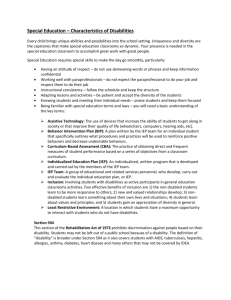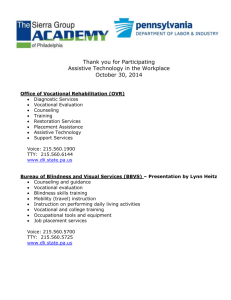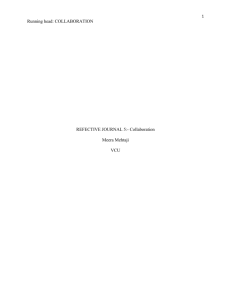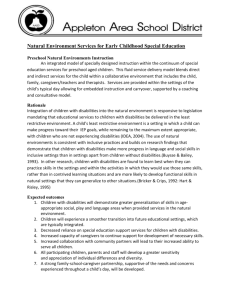RAPID CITY AREA SCHOOL DISTRICT
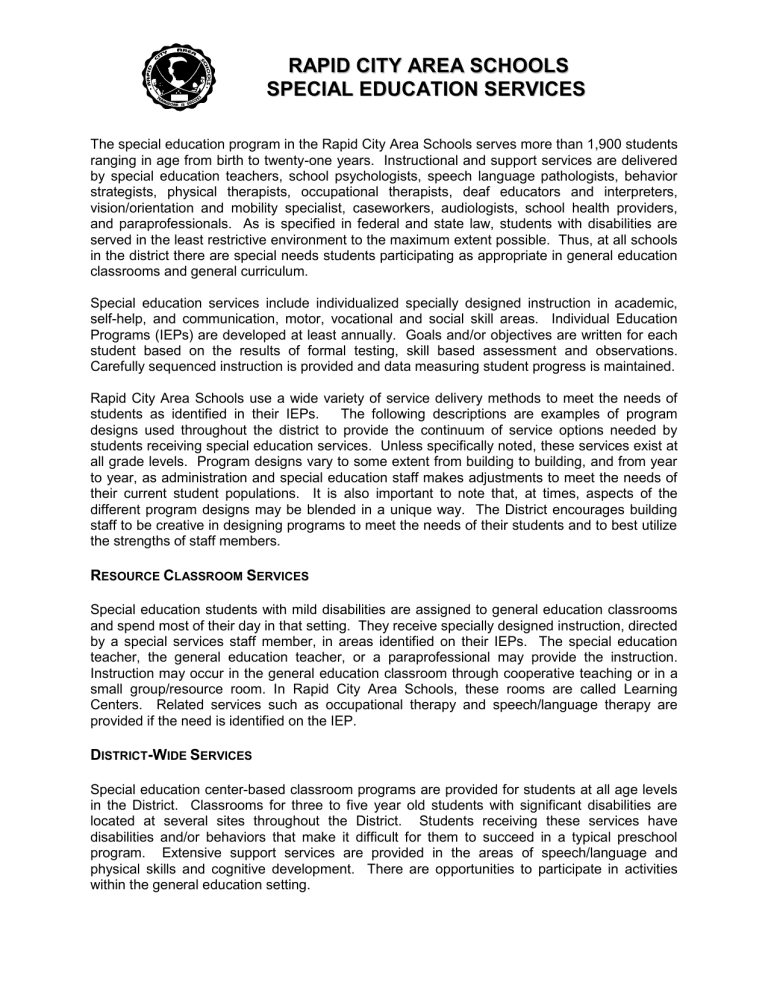
R A P I I D C I I T Y A R E A S C H O O L S
S P E C I I A L E D U C A T I I O N S E R V I I C E S
The special education program in the Rapid City Area Schools serves more than 1,900 students ranging in age from birth to twenty-one years. Instructional and support services are delivered by special education teachers, school psychologists, speech language pathologists, behavior strategists, physical therapists, occupational therapists, deaf educators and interpreters, vision/orientation and mobility specialist, caseworkers, audiologists, school health providers, and paraprofessionals. As is specified in federal and state law, students with disabilities are served in the least restrictive environment to the maximum extent possible. Thus, at all schools in the district there are special needs students participating as appropriate in general education classrooms and general curriculum.
Special education services include individualized specially designed instruction in academic, self-help, and communication, motor, vocational and social skill areas. Individual Education
Programs (IEPs) are developed at least annually. Goals and/or objectives are written for each student based on the results of formal testing, skill based assessment and observations.
Carefully sequenced instruction is provided and data measuring student progress is maintained.
Rapid City Area Schools use a wide variety of service delivery methods to meet the needs of students as identified in their IEPs. The following descriptions are examples of program designs used throughout the district to provide the continuum of service options needed by students receiving special education services. Unless specifically noted, these services exist at all grade levels. Program designs vary to some extent from building to building, and from year to year, as administration and special education staff makes adjustments to meet the needs of their current student populations. It is also important to note that, at times, aspects of the different program designs may be blended in a unique way. The District encourages building staff to be creative in designing programs to meet the needs of their students and to best utilize the strengths of staff members.
R ESOURCE C LASSROOM S ERVICES
Special education students with mild disabilities are assigned to general education classrooms and spend most of their day in that setting. They receive specially designed instruction, directed by a special services staff member, in areas identified on their IEPs. The special education teacher, the general education teacher, or a paraprofessional may provide the instruction.
Instruction may occur in the general education classroom through cooperative teaching or in a small group/resource room. In Rapid City Area Schools, these rooms are called Learning
Centers. Related services such as occupational therapy and speech/language therapy are provided if the need is identified on the IEP.
D ISTRICT -W IDE S ERVICES
Special education center-based classroom programs are provided for students at all age levels in the District. Classrooms for three to five year old students with significant disabilities are located at several sites throughout the District. Students receiving these services have disabilities and/or behaviors that make it difficult for them to succeed in a typical preschool program. Extensive support services are provided in the areas of speech/language and physical skills and cognitive development. There are opportunities to participate in activities within the general education setting.
Some school-age students with significant disabilities may also be enrolled in a special education district-wide classroom. Special education teachers and paraprofessionals staff these classrooms. The staff-to-student ratio is very low, and the curriculum is determined by the
IEP. The emphasis is on functional academics and life-long skills that are necessary for maximum independence. Even though the student is assigned to a special education classroom, he/she has frequent opportunities to participate with students without disabilities in both general education classroom and extracurricular settings.
The goal of the high school transition services is to help students with disabilities achieve the maximum independence possible. District-wide classes emphasize the acquisition of functional academics and skills necessary for independent living. There are classes designed to teach necessary job skills. When appropriate, students are mainstreamed into general education and resource classes.
The staff works to develop comprehensive work experience placements for each student. The work experience placements vary depending on the skills, maturity and age of the student.
Placements include: sheltered training, supervised work crew assignments in the community, school district job placements and job placements in the Rapid City area. Eligible students are referred to the Division of Developmental Disabilities or the Department of Vocational
Rehabilitation prior to graduation. The common goal for students is to transition into a job, further vocational training, or into state supported pre-vocational training and eventual employment.
C LASSROOM -B ASED S ERVICES
Some students who were traditionally served in self-contained classrooms, but who can function with some independence may be placed in general education classrooms with appropriate aids and services provided by the special education staff. The special education teacher, speech/language pathologist, physical therapist, occupational therapist, behavior strategist and paraprofessionals may work with the student in the classroom or in a special education classroom. The special education case manager is responsible for developing and managing the IEP and consults with the staff and family to ensure that the inclusion program is conducive to meaningful progress for the child.
School age students sometimes receive home-based services on a temporary basis because of health needs. The district strives to return these students to a regular school environment as soon as possible.
E ARLY I NTERVENTION S ERVICES
Child Find activities and screening for children birth to five years of age identify children who are developmentally on target in the areas of motor, concept development and communication.
Information on developmentally appropriate activities to enhance the child’s continual growth is shared at the time of screening. Referrals for children who may need a more comprehensive evaluation to determine the need for services will be made by the screening team. An evaluation may include educational, psychological, gross motor, fine motor, speech/language, and/or health.
Birth-five year olds who are found eligible through the evaluation process may be supported in the home, regular preschool and community settings. Those students requiring extensive services to meet their needs may be referred to one of the district’s 5 Early Intervention
Classrooms. Interdisciplinary teams including occupational therapists, speech/language
pathologists, physical therapists, psychologists, special education teachers, and paraprofessionals work together to provide on-going instruction, therapy and language training.
T RANSITION S ERVICES
All special education students age fourteen and above have a transition component on their
IEP. The purpose of transition services is to promote movement from school to post-school activities including post-secondary education, vocational training, integrated employment
(including supported employment) continuing and adult education, adult services, independent living, or community participation.
When appropriate, students with mild disabilities participate in the general education school-towork programs with additional guidance from the special education staff to identify individual vocational and employment goals. For students who require more support, transition activities may include: career exploration, program visits to vocational training centers and community colleges, assistance in selecting the right program, help with enrollment procedures, and followup to monitor success after placement. During transition, the district may help students access community services so they can plan for independent living arrangements, resolve transportation/mobility issues, and make connections with other appropriate adult service agencies.
If their IEPs specify the need, students who have vocational services, or others who may encounter significant challenges in their quest for suitable adult-oriented training, may receive enhanced transition services between the ages of eighteen and twenty-one. Students receiving these services typically have completed most of their academic secondary education and are ready to concentrate on vocational training and/or placement. Special education staff helps students and their families access services in the community that will better assure them of a reasonable quality of life as a young adult. These services are available only to students who have not graduated from high school. By law, students who have graduated are no longer eligible to receive special education services.
B EHAVIOR S UPPORT S ERVICES
The District provides additional services to students receiving special education services who are not experiencing school success because of behavioral/social/emotional concerns.
Services are provided by behavior intervention strategists and special services caseworkers.
The services are specific to current needs and include some of the following: assistance to special education and general education staff in writing and monitoring behavior intervention plans; family contacts and/or family histories, liaison with outside agencies as appropriate; classroom observations and/or consultation with teachers; consultation on Response to
Intervention (RtI); and other interventions as appropriate.
R ELATED S ERVICES
Related services means transportation and such developmental, corrective, and other supportive services as are required to assist a student receiving special education to be more successful in the educational setting. Related services are provided to special education students in the District as identified on IEPs. Services may be delivered in a regular classroom setting or in a separate setting as determined by the IEP team. Related services staff in the
Rapid City Area Schools include speech/language pathologists, audiologists, physical therapists, occupational therapists, school psychologists, orientation and mobility/vision, medical evaluations (for diagnostic purposes only), school health, transportation, and assistive technology devices and services.




